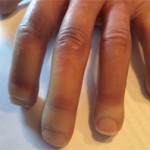“It was strange, but I developed heartburn for the first time since I was pregnant with our two girls. That’s why I take the …”
“The Zantac,” her husband finished.
“Right. So that helped some. But then the fingers became puffy and swollen, and my hands itched. When the itching spread to my arms and chest, it drove me crazy, especially at night, couldn’t sleep, and the heartburn worsened, so …. Was that when we increased the Zantac to twice a day, Michael?” she asked.
“Right. And we made the appointment for the rheumatologist at the arthritis center.”
“They were very nice; they gave me doxepin for the itching and told me it looked like I had early scleroderma.” She reached up and scratched her forehead with her free hand, winced and shifted slightly. Her voice dropped off. “I think you can take that last roll of gauze off. I’m okay.”
I reached over and pulled at the end of the gauze. A sliver of scab and pink tissue came with it. “Sorry,” I mumbled, staring at the wound. It looked raw and painful. The edges were bluish black. My first impression was that the distal finger should be amputated and be done with it. It looked that bad. “Okay,” I exhaled, “let’s protect the finger, while I go through the rest of your history and exam,” I said as I lightly rewrapped the wound.
I looked down at my notes, “So when did the skin-tightening begin?” I felt awkward, intensely aware of her discomfort.
“Six, maybe eight months ago. The skin tightened wherever there was originally swelling; first the fingers and toes, then the back of my hands, forearms and ankles, more recently, the neck and face. I got depressed. I mean, I am depressed, can’t sleep, the fingers were painful. They’re still painful.”
“Cough? Shortness of breath?” I asked.
“No, but I really can’t do much.”
“And the weight loss? It looks like from your internist’s notes, that you’ve lost about 30 lbs. in the past six months?”
“That’s stabilized,” her husband interjected. “Anyway, her weight stabilized at about 105 lbs. when they admitted her at the University of Arizona and found the scleroderma had affected the bowel. When a feeding tube didn’t work out, they placed the central line about two months ago.
I ran my finger down the intake sheet. “Your blood pressure. 138/86. It’s a bit up. Is that new?”



